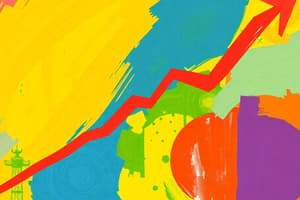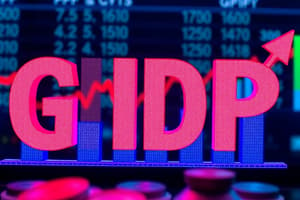Podcast
Questions and Answers
What metric is commonly used to measure economic growth?
What metric is commonly used to measure economic growth?
- Gross Domestic Product (GDP) growth rate (correct)
- Consumer Price Index (CPI)
- Unemployment Rate
- Inflation Rate
Extensive growth focuses on increasing the productivity of existing production factors.
Extensive growth focuses on increasing the productivity of existing production factors.
False (B)
According to Robert Solow, what was the primary driver of economic growth in the mid-19th century that accounted for the majority of the growth?
According to Robert Solow, what was the primary driver of economic growth in the mid-19th century that accounted for the majority of the growth?
technological progress
Joseph Schumpeter described the process where new innovations render older industries obsolete as ________ ________.
Joseph Schumpeter described the process where new innovations render older industries obsolete as ________ ________.
Match the following types of innovation with their descriptions:
Match the following types of innovation with their descriptions:
According to the concept of exogenous technological progress, where does technological advancement primarily originate?
According to the concept of exogenous technological progress, where does technological advancement primarily originate?
Endogenous technological progress posits that technological advancements are solely the result of random, unpredictable discoveries.
Endogenous technological progress posits that technological advancements are solely the result of random, unpredictable discoveries.
What role do patents play in promoting innovation, according to the discussion of institutions and economic growth?
What role do patents play in promoting innovation, according to the discussion of institutions and economic growth?
According to Douglas North, institutions are the ________ set by humans that shape the incentive structure of an economy.
According to Douglas North, institutions are the ________ set by humans that shape the incentive structure of an economy.
Which of the following is NOT identified as a factor that can impede investment and, consequently, economic growth?
Which of the following is NOT identified as a factor that can impede investment and, consequently, economic growth?
Innovation always leads to a more equitable distribution of wealth across all segments of society.
Innovation always leads to a more equitable distribution of wealth across all segments of society.
What is 'Total Factor Productivity' (TFP), and how is it used to assess economic growth?
What is 'Total Factor Productivity' (TFP), and how is it used to assess economic growth?
In the context of the relationship between technology and job sectors, what typically happens to 'intermediary' jobs as a result of process innovation?
In the context of the relationship between technology and job sectors, what typically happens to 'intermediary' jobs as a result of process innovation?
The Brundtland Report suggests that economic growth should always be prioritized, even at the expense of environmental sustainability.
The Brundtland Report suggests that economic growth should always be prioritized, even at the expense of environmental sustainability.
The exhaustion of ________ ________ and the generation of negative externalities are two significant negative consequences of unchecked economic growth.
The exhaustion of ________ ________ and the generation of negative externalities are two significant negative consequences of unchecked economic growth.
Which of the following best describes the perspective of neoclassical theorists regarding natural capital?
Which of the following best describes the perspective of neoclassical theorists regarding natural capital?
Explain how creative destruction can simultaneously drive economic growth and exacerbate economic inequality.
Explain how creative destruction can simultaneously drive economic growth and exacerbate economic inequality.
According to the content, policies like the Kyoto Protocol and the Paris Agreement aim to accelerate the exhaustion of natural capital to promote faster economic growth.
According to the content, policies like the Kyoto Protocol and the Paris Agreement aim to accelerate the exhaustion of natural capital to promote faster economic growth.
According to Joseph Schumpeter, ________ are vital to innovation because they seek to implement new technologies to gain a monopoly.
According to Joseph Schumpeter, ________ are vital to innovation because they seek to implement new technologies to gain a monopoly.
Which of the following is a key difference between 'weak' and 'strong' sustainability?
Which of the following is a key difference between 'weak' and 'strong' sustainability?
Flashcards
Economic Growth
Economic Growth
Long-term increase in the production of goods and services, measured by GDP growth rate.
Extensive Growth
Extensive Growth
Economic growth is driven by increasing the quantity of production factors used, such as labor and capital.
Intensive Growth
Intensive Growth
Economic growth is driven by increasing the productivity of the current production factors through improved efficiency.
Total Factor Productivity (TFP)
Total Factor Productivity (TFP)
Signup and view all the flashcards
Innovation
Innovation
Signup and view all the flashcards
Exogenous Technological Progress
Exogenous Technological Progress
Signup and view all the flashcards
Endogenous Technological Progress
Endogenous Technological Progress
Signup and view all the flashcards
Institutions
Institutions
Signup and view all the flashcards
Creative Destruction
Creative Destruction
Signup and view all the flashcards
Sustainable Growth
Sustainable Growth
Signup and view all the flashcards
Physical Capital
Physical Capital
Signup and view all the flashcards
Human Capital
Human Capital
Signup and view all the flashcards
Study Notes
Definition of Economic Growth
- Economic growth pertains to the long-term increase in the production of both goods and services.
- It is measured using the Gross Domestic Product (GDP) growth rate, which reflects the creation of wealth within a country in a given year.
- GDP is calculated by totaling the added values of organizations, both commercial and non-commercial, like public administrations.
Origins of Economic Growth: Two Main Theories
- There are two main schools of thought regarding the factors of economic growth: extensive growth and intensive growth.
Extensive Growth
- The rise in the quantity of production factors used in an economy drives economic growth.
- This involves increasing the amount of labor used, such as by raising the number of employed individuals or extending working hours.
- This also involves increasing the amount of capital, which includes durable production goods, where increased investment occurs.
Criticism of Extensive Growth
- The law of diminishing returns that states that as more workers or machines are added, the productivity of the last unit decreases, potentially leading to a stationary state where economic growth becomes negligible.
Intensive Growth
- Intensive growth means focusing on increasing the productivity of production factors, rather than just accumulating more of them.
- Robert Solow found in 1950 that economic growth was not slowing down.
Robert Solow's Findings
- Solow found that the accumulation of labor and capital only accounted for 25% of economic growth since the mid-19th century.
- Solow attributed the remaining portion to productivity, specifically through technological progress that transforms products and production activities.
- The impact of technological progress on productivity, and thus economic growth, is measured using Total Factor Productivity (TFP).
- TFP measures the economic growth linked to efficiency by subtracting the growth due to increased use of labor and capital from the overall GDP growth.
Innovation
- Innovation, a crucial element per this chapter, has different forms according to Joseph Schumpeter.
- The forms can include new products, new markets, process innovation (transforming production methods), organizational innovation, commercial innovation (changing how to sell), and discovering new sources of raw materials.
Origins of Technological Progress: Two Perspectives
- There are two schools of thought: exogenous technological progress and endogenous technological progress.
Exogenous Technological Progress
- Proposes that technological progress comes from outside the economy.
- Robert Solow suggests that technological progress stems from fundamental scientific discoveries, which he describes as "falling from the sky".
- The progress occurs from the genius of researchers and scientists, exemplified by James Watt's invention of the steam engine that significantly boosted productivity during the Industrial Revolution.
Endogenous Technological Progress
- Claims that technological progress originates from within the economy, driven by the decisions of economic agents such as firms and the state.
- Innovation is the industrial and commercial application of an invention.
- Engineers and technicians play a role in making an invention a reality.
- Funding for research and development (R&D), dividing into basic research (developing new knowledge) and applied research (applying new knowledge to invent).
- State invests in R&D through universities.
Stages of Innovation
- Jeff Bezos (Amazon) and Mark Zuckerberg (Facebook) commercialized internet.
- Henry Ford used the assembly line in his automobile factories.
- Joseph Schumpeter says that entrepreneurs are vital as they seek to innovate to gain a monopoly.
- Elon Musk and his electric cars, achieving a monopoly position.
- State plays role by investing in human capital.
Role of Institutions in Economic Growth
- Play role that directly impacts investment and innovation.
- Douglas North says institutions are constraints set by humans.
- The constraints include rules of law, the fiscal system, political structures, and social norms.
- Respect for property rights is essential for market exchanges and incentivizes production.
- Patents protect innovators by granting a temporary monopoly on their innovations.
- Entrepreneurs innovate because patents exist, and the entrepreneurs want to benefit from rents.
- Fiscal or tax systems, enable to finance infrastructure which is good for business.
Factors That Stop Investment
- Corruption and leaders are not credible.
- Social norms are important to impact economic activities.
- Thailand and Prescott state that bad institutions stop certainty long term.
- Economic shocks are not credible long term and neither are regulations.
- Solutions to help boost the economy include the creation of rules.
Limitations of Economic Growth: Impact on Employment and Inequality
- Schumpeter introduces the concept of creative destruction, where emerging innovations create new activities while making older ones obsolete.
- Creative destruction involves replacing old activities.
Impact of Innovation on Economic Equity
- Innovations worsen economic equity by increasing the wealth of those already rich.
- Innovators like Jeff Bezos, Bill Gates, and Mark Zuckerberg have gained a lot of money due to the monopoly.
- There is a strong connection between the increase in patent filings and the increase in income. Innovation has helped certain sectors see increased profits.
- Creation of innovation, creating geographical divide.
- Job polarization, separating jobs into categories.
The relationship between Technology and Job Sectors
- Process innovation is when jobs are created in the workforce, but not all positions are filled.
- Intermediary jobs are replaced because tech will do the job.
- Higher up positions are not replaced as its human skill.
Negative Consequences of Economic Growth
- The report by Meadows in 1972 anticipates blocked economic growth by 2010.
- The block is do to human activity using up natural resources.
Impact of economic growth
- Exhausting natural capital, which is shared resource.
- Generating negative externalities, like pollution, meaning affecting other economic agents.
- Decreasing the number of trees is leading to climate change because trees stop taking carbon dioxide.
The Brundtland Report (1987)
- Brundtland says that economic growth occurs with any compromise.
Growth
- Economic growth leads to sustainable ways to limit negative externalities and the overuse of natural capital.
- The Kyoto Protocol and the Paris Agreement attempt to limit externalizes (pollution, etc).
Sustainable growth
- There are people who believe in weak and strong sustainability
- Theorists from neo classical, oppose intervention with markets and believe in a free market.
- There is no problem destroying natural capital.
Capital should have three factors
- Physical capital: durable production goods
- Human capital: a society with good health
- A strong technological capital is a requirement
- Free market to encourage development
Theorisists- strong sustainability
- The technical aspects are important to fix the environment and damage.
- A car that uses electricity isn't tech just capital it needs to work therefore they are related.
- They prevent problems like overuse and damage to natural resources.
- Innovation can create growth that is sustainable.
Studying That Suits You
Use AI to generate personalized quizzes and flashcards to suit your learning preferences.




